- Peas are an easy-to-grow, fast-maturing vegetable that requires minimal care, making them ideal for home and indoor gardening.
- All parts of the pea plant like pods, seeds, leaves, stems, and tendrils are edible and versatile in cooking.
- Growing peas at home provides fresh, sweet-tasting produce with high nutritional value, including protein, fiber, vitamins, and minerals.
- Peas improve soil health naturally by fixing nitrogen, reducing the need for chemical fertilizers and benefiting crop rotation.
Vegetables are rich in vitamins, minerals, and fibers, making the diet healthy. It can be grown at home, adding a fresh taste. However, every vegetable is not easy to grow because of their different harvesting methods and sowing processes, so gardeners do not consider growing vegetables much. However, peas are easy to grow and have a fast growth rate, requiring only a little care from gardeners.
Peas are green pods or seeds of the pea plant, known as one of the first-season growing vegetables. The vines are also edible and can be eaten raw, frozen, in soups, salads, or cooked in many dishes, making peas a versatile food.
With their early spring planting, peas are considered perfect for indoor gardening as they bloom with pretty flowers that turn into delicious pods. Growcycle offers gardeners multiple harvesting methods and care tips to grow healthy peas in homes.
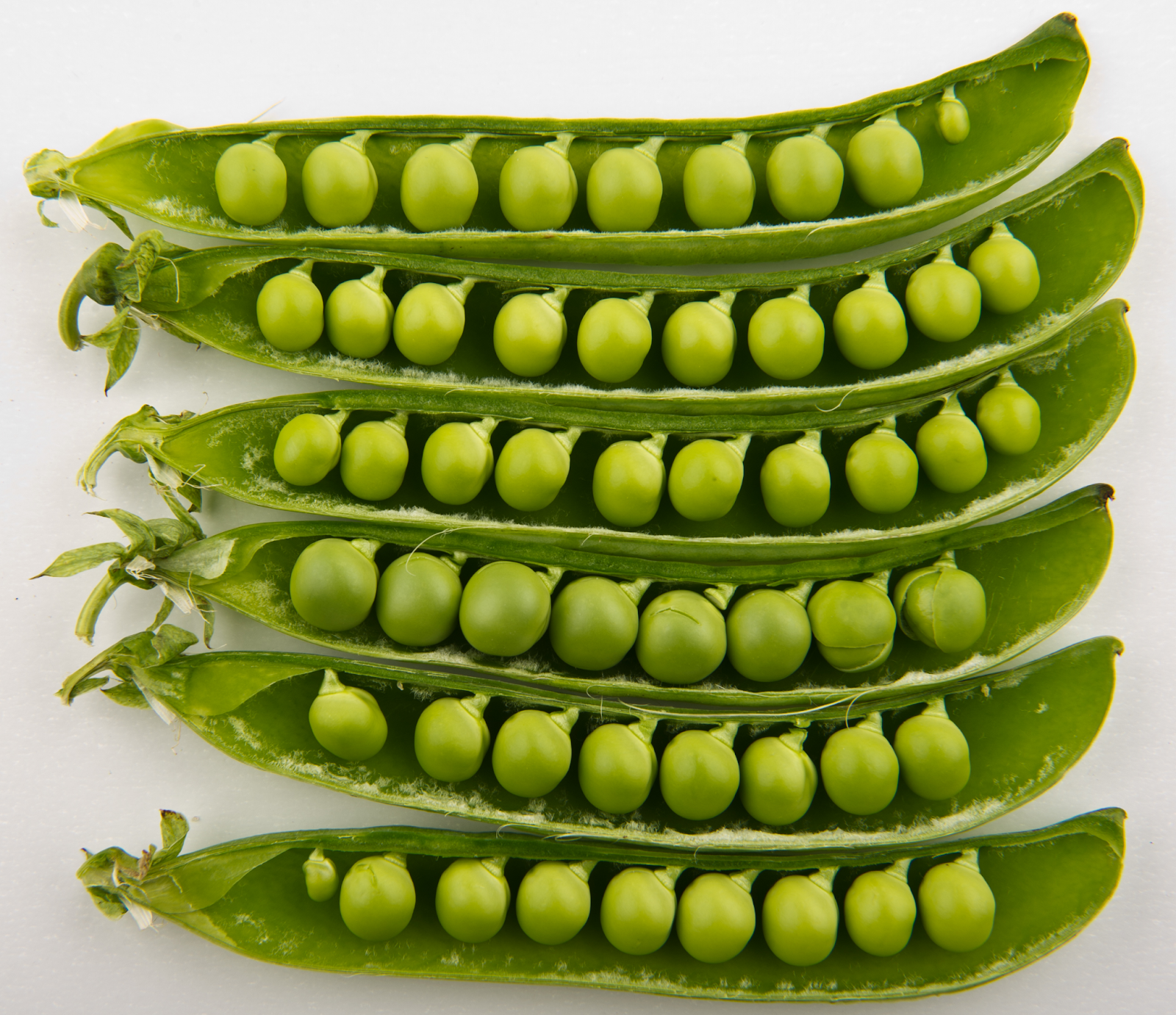
Botanical Description
Peas are a popular vegetable grown in home gardens around the world. Here is an overview of their botany:
Family:
- The pea is an annual herbaceous plant that belongs to the Fabaceae family.
- It is grown worldwide for its edible seeds and is a popular indoor vegetable in many regions.
Root System
- The pea plant has a shallow root system with most feeding roots near the surface.
- Usually, it has a tap root that grows up to three feet deep and supports the plants.
- Smaller roots branch out from the tap root to help absorb nutrients.
Stems
- Pea plant stems are hollow and can grow as long as 6 feet, allowing the plant to spread or climb.
- These stems can either trail along the ground or climb up supports.
Tendril
- They are modified leaves or stems and are sometimes called pea shoots.
- Pea tendrils are curling, thread-like parts of the plant that help it climb.
Seeds
- Pea seeds are large, with about 4,000 seeds per pound.
- Usually, they are spherical and have multiple colors, such as white, gray, green, or brown.
Pods
- Pea pods are the seed cases of the pea plant, which are sweet and starchy.
- Pea pods are considered fruit because they develop from a flower's ovary and contain seeds.
Leaves
- The leaves of this plant are green and have a leaf-like texture.
- Each leaf includes a pair of stipules at the base, a petiole, and a cluster of tendrils.
- They have an oval, half-heart shape that is narrow at both ends and wider at the center.
- They consist of multiple leaflets, with a single main vein running from base to tip.
Flowers
- Pea flowers are irregular, with five asymmetrical petals containing both male and female parts.
- They can be white or violet and are self-pollinating.
- The flowers consist of a keel, banner, and wings that help in the self-pollination process.
Growth Habit
- Vining Peas: These peas grow tall and need something to climb on, like a trellis or stakes.
- Bush Peas: These peas stay short and don’t need any support to grow.
Characteristics of Peas
Peas are versatile, cool-season vegetables known for their sweet seeds and unique pod structures. Here are some of the main features of this plant:
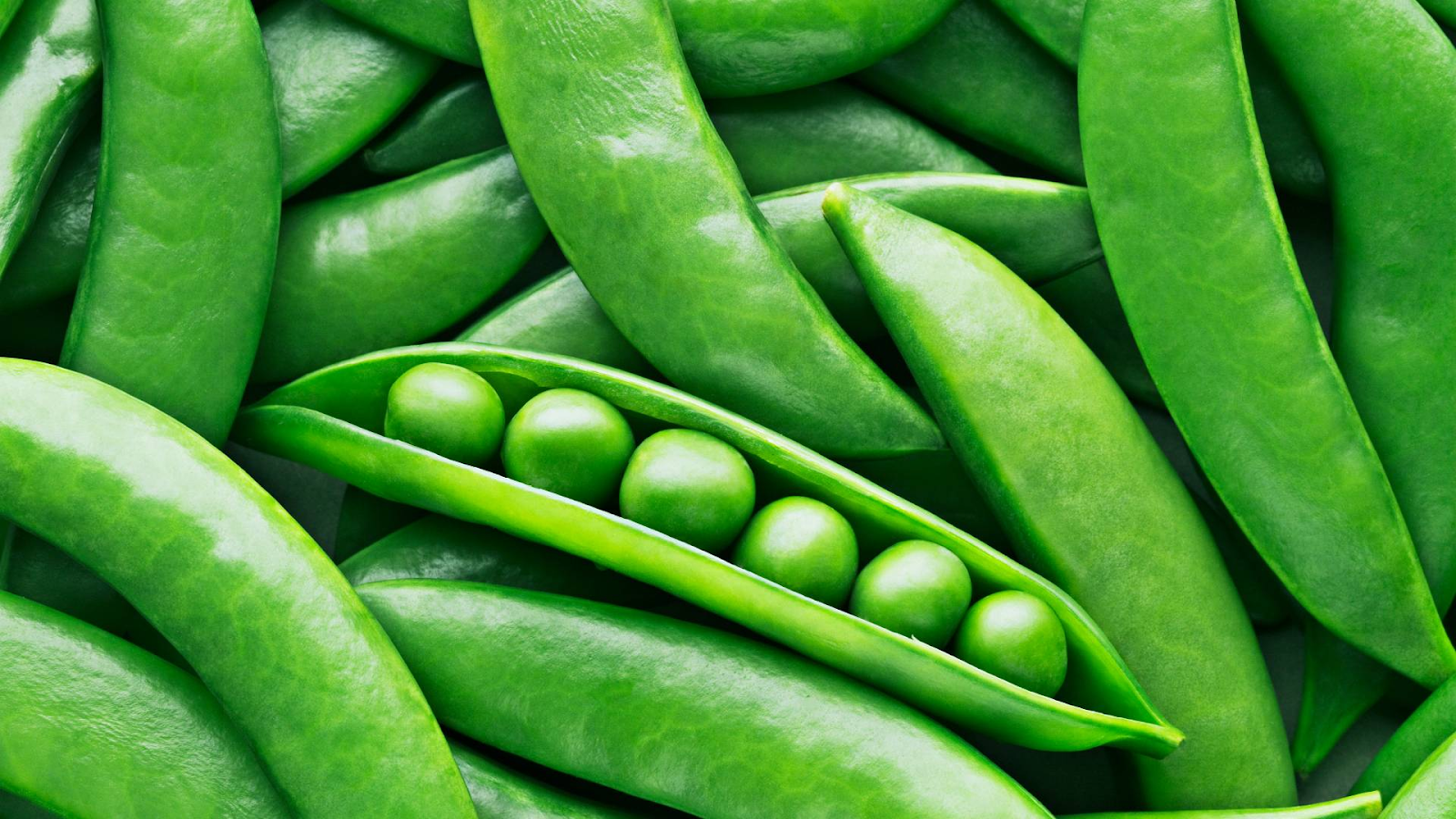
Appearance
- Color: The pea plant is usually green, and it is widely used as food. Other pea colors include golden yellow, cream yellow, chartreuse, army green, and dark green.
- Shape: This plant mostly has a pod shape, which can be round and hung down from 3 to 15 cm long. However, the seeds inside these pods are usually spherical and have a wrinkled structure.
- Size: Fresh green peas are usually about 8.5 mm to 10.2 mm long, averaging 9.38 mm. However, garden peas range from 7.5 mm to very fine, 8.2 mm to very fine, and 9.3 mm to simply fine.
Texture
Peas have different textures depending on their variety and processing. Garden peas are mostly smooth and round, with a starchy, sweet taste. Snap peas are crunchy, while black-eyed peas are firm, dense, and soft when cooked. Snow peas are flatter, allowing the seeds to show different textures.
Flavor
Peas are commonly used as green vegetables in meals. They have a mild, sweet, and savory flavor. However, some varieties of this plant are sweeter than others, such as pea proteins, which have a beany flavor.
Benefits of Growing Peas at Home
Growing peas indoors is a great way to enjoy fresh, healthy garden food. Here are some of the main benefits of growing peas at home:
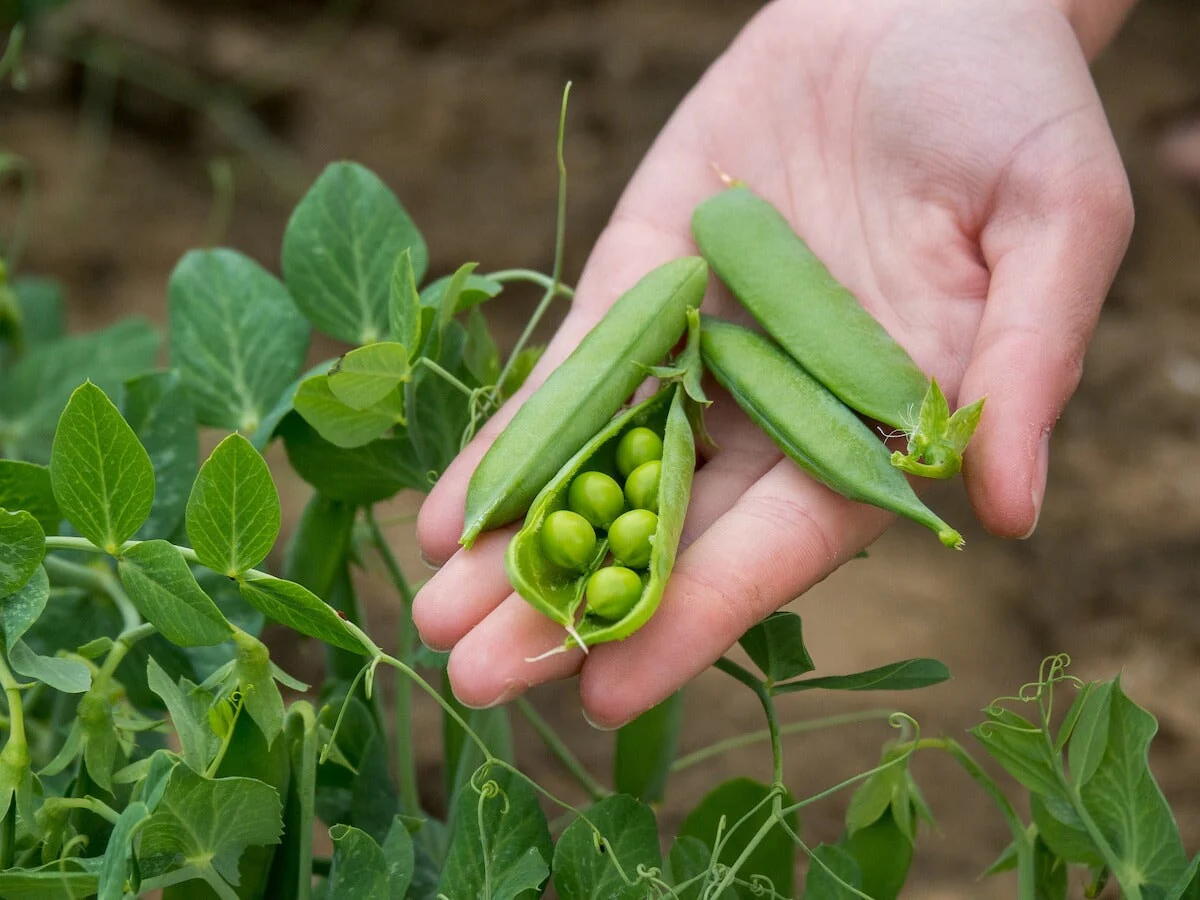
- Eco-Friendly: Peas are eco-friendly as they help improve soil health. By fixing nitrogen from the air, they reduce the need for chemical fertilizers, making them a sustainable crop.
- Low Maintenance: This vegetable is easy to grow because it tolerates various conditions and needs only moderate watering and occasional pest control. It requires little care, making it easy for busy gardeners.
- Fresh Taste: Home grown peas have a fresh, sweet taste because they are picked while their sugar content is high. When harvested, they lose their sweetness as the sugars become starch, making home-grown varieties better than store-bought ones.
- Space Saving: As it has climbing growth, it uses little space from gardens, making it efficient to grow in a limited space.
- Nutritional Value: Homegrown peas are healthy and full of protein, fiber, and important vitamins, such as vitamins A, B, C, and K, as well as minerals. They help with digestion, immune health, and strong bones. Because of their high protein content, they are especially beneficial for plant-based diets.
- Improves Soil Health: They help improve soil health by fixing nitrogen from the air and adding it into the soil through their roots. This natural process is a fertilizer, making them ideal for crop rotation in home gardens.
- Wholly Edible: It is interesting that all parts of peas, such as leaves, stems, pods, and seeds, are edible. These can be used in cooking, making them versatile and reducing waste. Hence, it helps to eat healthy, fresh vegetables instead of store-bought ones.
Grow Peas At Home: A Step-by-Step Guide
Peas are a healthy and tasty vegetable easily grown at home. Here is a simple step-by-step guide to grow peas indoors:
Step 1: Select the Right Pea Variety
Peas come in multiple varieties and require different growing conditions. Hence, choosing the right variety when growing peas at home is important.
| Type of Peas | Characteristics | Best Uses | Special Notes |
| Garden Peas | Smooth peas are complex and suited for early planting; wrinkled peas are sweeter and thrive in summer. | Shelling, cooking, or freezing | Choose wrinkled peas for a sweeter flavor. |
| Mangetout Peas | Flat, stringless pods can be eaten whole. | Best when picked before peas mature; stir-fries. | Easy to grow; high yields when harvested early. |
| Snow Peas | Edible flat pods with small seeds. | Asian stir-fries, sautéing, or salads. | Tender pods are great for quick cooking. |
| Snap Peas | Fat, juicy, and sweet pods. | Healthy snacks or quick cooking. | Mature in under 60 days; early harvest variety. |
Step 2: Prepare the Ground
Choose a sunny, sheltered area with good air circulation. Ensure the soil is loamy and well-drained, as this helps pea plants grow healthier. Add at least two bucketfuls of compost or manure per square meter/yard to improve soil quality and drainage.
Gardeners can use lime to raise the pH if the soil is too acidic. Before planting, clean the area thoroughly to remove any weeds or pests, as they can damage the whole vegetable growth.
Step 3: Set the Tray
Peas thrive better in clay soil when started in trays and transplanted as seedlings. This approach helps prevent seed rotting in heavy, wet soil and ensures healthier growth. Here are the best methods to achieve this:
- Use Plug Trays: Use sow peas in plug trays to minimize root disturbance during transplantation. Each cell holds a single seed, ensuring well-spaced growth.
- Toilet Roll Method: Place seeds inside biodegradable toilet rolls filled with compost. Plant the entire roll directly in the soil, avoiding any root disruption.
- Tray and Pot Sowing: Use deep modular trays or small pots filled with peat-free compost. Sow 1–3 seeds per pot or one seed per tube/module at a depth of about 2 inches. This method provides enough room for roots to develop before transplanting.
Step 4: Sow the Seed
Sowing peas can be done either indoors or outdoors, depending on the weather and soil conditions:
- Indoor Sowing: Start sowing seeds in February or March to avoid the cold and wet outdoor conditions that can cause seeds to rot. Indoor sowing protects seeds from pests like mice and allows plants to be established before being transplanted outdoors.
- Outdoor Sowing: Wait until the soil temperature reaches at least 50°F, typically between March and June. Ensure the soil is well-drained and not overly damp to prevent seed rot. For taller pea varieties, sow seeds 3 inches apart, leaving 12 inches between rows to allow room for growth.
- For Easy Transplantation: Sow peas in a length of guttering for hassle-free transplanting. Place seeds approximately 3 inches apart in a double row. This method simplifies moving young plants outdoors when they are ready to be planted in their final position.
Step 5: Provide Support
- Use Bamboo Canes: Place bamboo canes 12 inches apart and tie them together. For the extra support, gardeners can add netting or chicken wire.
- Use Pea Sticks: Use twiggy prunings from fruit trees between plants. This is a cheap option that lasts a few years.
- Use Twine and Trellis: A lightweight trellis can control diseases and make picking easier. However, gardeners can also tie plants by weaving twine between them as they grow.
Care Guide for Home Grown Peas
Peas are perfect for gardens of all sizes and can be enjoyed fresh or cooked in many dishes. However, gardeners need to be careful about some factors while growing:
1. Water
Regular watering is important for peas' healthy growth. Gardeners must water them regularly to keep the soil moist, but they should not overwater, as this can harm the roots.
During dry spells, check the soil moisture before watering, as more frequent watering may be needed. Hence, it is better to water deeply once or twice a week, ensuring the soil is soaked about an inch deep.
2. Light
This vegetable needs at least six hours of sunlight daily to grow well. It is best to place the plant near a sunny window, such as a south-facing one to get enough light.
Although it can grow in some shade, this may reduce the number of peas and affect their taste. Hence, gardeners need to use artificial grow lights for better and more effective growth in low light cases.
3. Soil
Peas grow well in various soil types as long as there is good drainage. They prefer loamy, well-drained soil with a pH between 6 and 7.5. Gardeners can add mixed compost or spread it in sandy soil to improve drainage and quality. Peas are light feeders and nitrogen fixers, so they do not require overly rich soil.
4. Mulching
Garden compost can be a good way to retain moisture. It helps keep the soil cool and prevents it from drying out during hot weather. Hence, gardeners need to apply a 2—to 4-inch layer of mulch covering a 4-inch-wide row with about 2 inches extending on either side of the plants.
5. Temperature and Humidity
Usually, the pea plant thrives in mild temperatures ranging from 60 to 70°F and can tolerate cold conditions. However, it can be affected if temperatures exceed 85°F. Further, there is no need to worry about humidity, as this plant's soil remains moist primarily.
How to Make Trellis for Peas Support
A trellis is a great way to support peas as they grow. Here are three simple ideas for building a trellis for peas support:
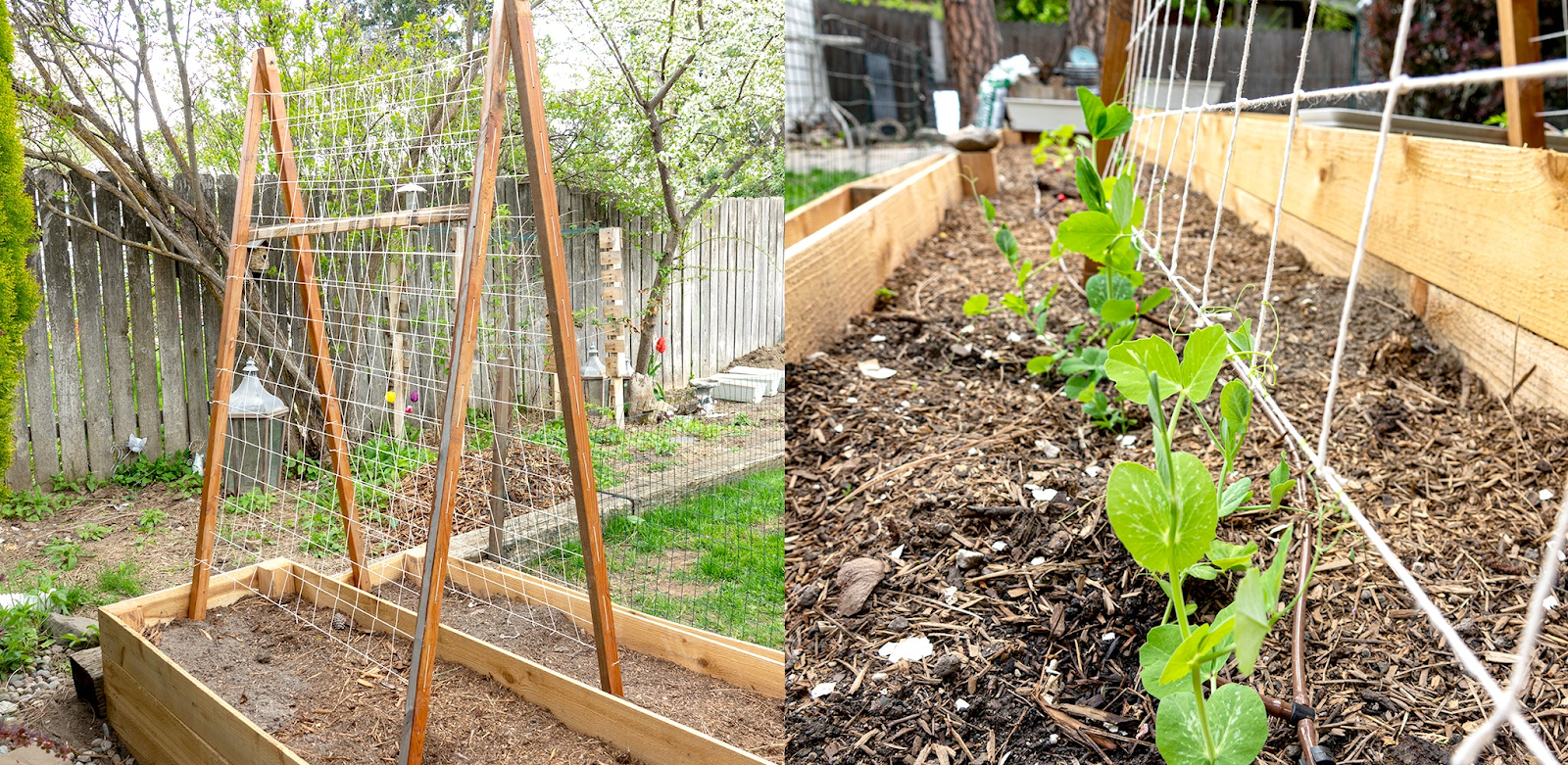
- Bamboo and Twine Trellis: To make a trellis, use bamboo posts and twine to create a conical-shaped structure. Then, tie the posts at the top and spread them into a circle, weaving twine between them for added support.
- Posts and Netting: Place vertical posts at least 4 feet apart and hang netting between them for peas to climb. Gardeners need to secure the netting with zip ties for a firm and strong structure.
- Posts and Wire Mesh: Attach wire mesh panels to wooden posts for a strong, long-lasting trellis. Also, use the zip ties to secure the mesh and plant peas along the bottom for support.
Harvest and Store Fresh Peas at Home
Peas with a fresh taste should be harvested at the right time for healthy peas. It is better to pick when the pods are swollen with peas, usually 60-70 days after sowing. However, different varieties show specific signs of harvest, so gardeners need to check the plants regularly.
- Harvest peas with clean and sharp tools such as pruners or scissors.
- Cut the stem just above the pod to avoid damaging the plant.
- Start the harvesting at the base of the plant and move upward.
- Hold the stem with one hand and gently pinch or pull the pods off with the other to protect the plant from harm.
Eating the peas quickly after harvesting is always better than storing them. However, if storing peas is needed, here are some tips to follow:
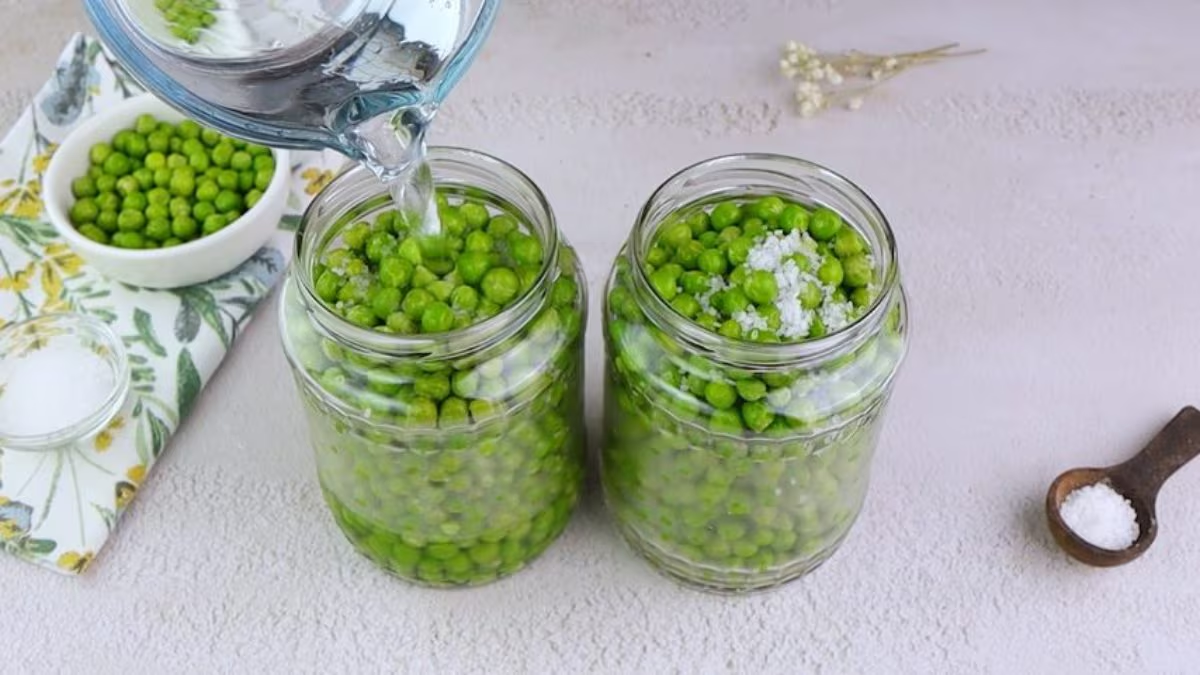
- Use a Perforated Bag: This allows air to circulate and keeps the peas cool.
- Refrigerate: Store the peas in the fridge for up to a week to maintain freshness.
- Keep in Freezer: If it is needed longer, use the freezing method. For this, people must spread peas on a parchment-lined baking sheet and freeze for about an hour. Then, transfer them to a freezer-safe bag or container, where they can be stored for up to a year.
Problems to Grow Growing Peas and Solutions
Growing peas can have some challenges but they can grow quickly with the right solutions. Here are some common problems and how to fix them:
1. Deformed Leaves
Cause: Pest infections, most likely aphids, powdery mildew, lack of nutrients, water stress, or temperature changes.
Solution:
- Place the pea plant in a wide space to improve airflow.
- Check the plant regularly for any pest and weed attacks.
- Use insecticidal soap and fungicide to treat pests such as aphids and powdery mildew.
- In case of low nutrients, fertilize the plant regularly with a balanced fertilizer.
2. Yellow Spots
Cause: Improper watering, lack of nutrients, fungal diseases such as powdery mildew and downy mildew, and pest attacks like aphids.
Solution:
- Water the plant regularly to moisten the soil, but do not overwater it to make it soggy.
- Place the plant at different locations each year to avoid diseases.
- Check for the pests regularly and use insecticidal soap to treat them.
3. Purple Specks
Cause: Fungal disease called Ascochyta blight.
Solution:
- Remove the infected plant using sharp scissors, such as purple spots on leaves, stems, and pods.
- Use clean pea seeds in the sowing process to avoid these issues.
- Rotate the pea plant regularly to avoid the spread of this disease.
Summary
Peas are easy to grow at home. They have a pod shape and asymmetrical flowers with multiple leaflets. They are green in color and can be used for various cooking purposes, from salads and soups to dishes.
When peas grow in regular conditions and are harvested at the proper time, they have a fresh, juicy taste that makes them a perfect indoor vegetable. Visit Growcycle for expert advice on how to grow homegrown vegetables with the right care.
Disclaimer: This material is for informational purposes only and should not be relied on for legal, medical, financial, or any other form of professional advice.

